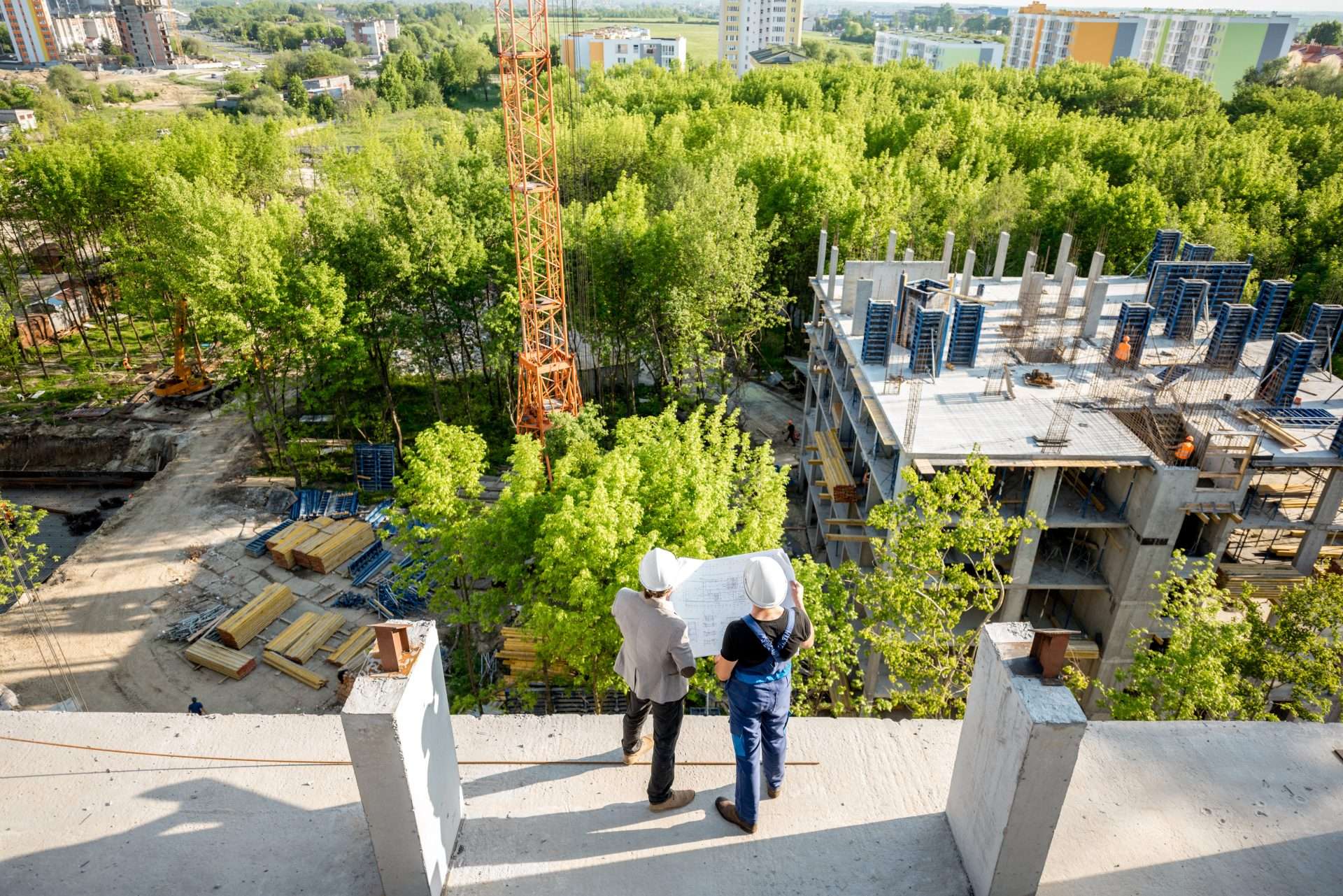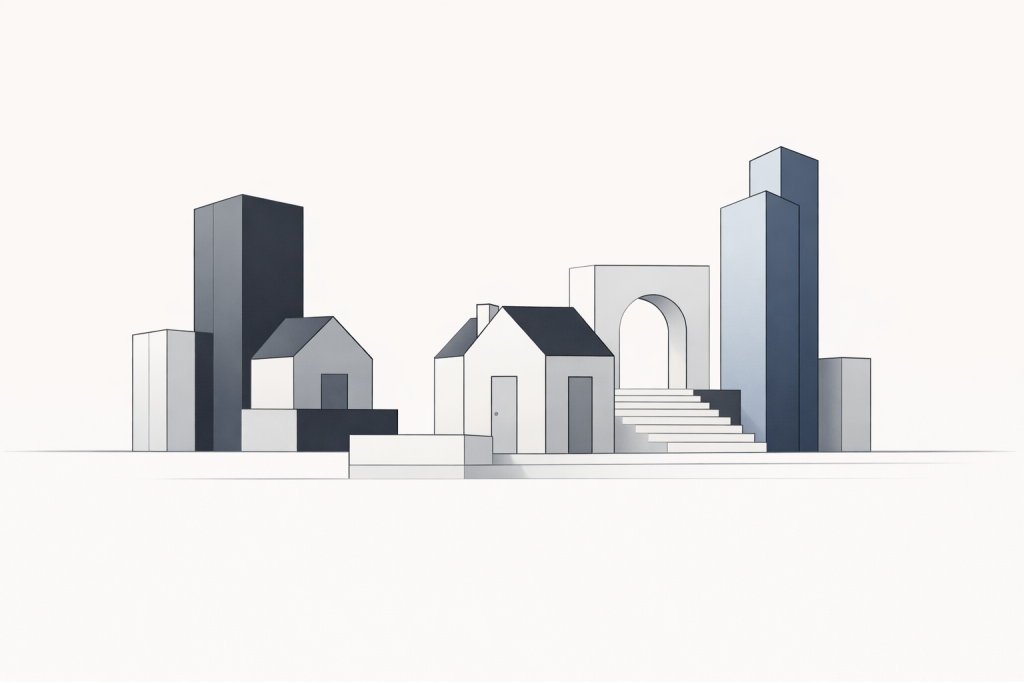Did you know that nearly 70% of new homes in the United States are built by home developers? This statistic highlights the crucial role these professionals play in shaping our residential landscapes. Home developers and builders are often confused, but understanding their distinct functions is essential for anyone involved in real estate or considering a new home purchase.
The world of residential construction involves various key players, each with unique responsibilities and expertise. This article delves into the primary differences between home developers and builders, exploring their roles in land acquisition, home design, and construction processes. By examining their contrasting approaches to project management, subcontractor relationships, and client interactions, readers will gain valuable insights into the complexities of home development and construction.
Roles and Responsibilities
Developer’s Role
Real estate developers are the masterminds behind transforming raw land or existing properties into profitable ventures. They play a crucial role in identifying potential development opportunities, acquiring land or properties, securing financing, and overseeing the entire project from start to finish [1]. These professionals possess a unique blend of skills, including a deep understanding of market trends, zoning regulations, construction processes, and financial analysis.
Developers are responsible for creating a vision for the project and executing it. They work on:
- Land acquisition and development
- Obtaining necessary permits and approvals
- Creating building lots
- Installing infrastructure (sewers, water lines, electric lines, streets, and curbs)
- Selecting builder partners to construct homes on the developed land [2]
It’s worth noting that some companies serve as both developers and builders, offering comprehensive real estate solutions. For instance, Primior acts as a developer, architect, and manager of real estate, providing full-service, turnkey solutions for various projects.
Builder’s Role
Builders, on the other hand, focus on the actual construction of homes within the developed community. Their primary responsibilities include:
- Managing architectural plans and construction permits
- Controlling subcontractors
- Overseeing the construction process
- Ensuring quality workmanship
- Keeping the project on schedule and within budget [3]
Builders often work in partnership with developers to maintain the original vision for the community. They may specialize in different product types, depending on market demand and their particular area of expertise [2].
Key Differences
While developers and builders work closely together, their roles and responsibilities differ significantly:
- Scope of Work: Developers focus on the broader aspects of community development, including land acquisition, planning, and infrastructure. Builders concentrate on the construction of individual homes or structures within the developed area [2].
- Project Timeline: Developers are typically involved in the community for a longer period, from the initial planning stages until the community is complete. Builders may enter the project later, focusing on the construction phase [2].
- Financial Aspects: Developers often carry the financial burden of land ownership for extended periods, while builders aim to minimize their land inventory, often taking options on lots rather than developing them themselves [4].
- Expertise: Developers need a broad range of skills, including market analysis, financial planning, and project management. Builders require specialized knowledge in construction techniques, building codes, and materials [1] [3].
- Risk Level: Developers generally assume higher risks due to the long-term nature of their investments and the complexities of land development. Builders face more immediate risks related to construction costs and timelines [4].
Understanding these distinctions is crucial for anyone involved in real estate or considering a new home purchase. Both developers and builders contribute significantly to shaping residential landscapes and creating thriving communities.
Land Development Process
Land Acquisition
Land acquisition is a complex and critical process in real estate development. It involves acquiring parcels of land for various purposes, including residential, commercial, or industrial projects. This process requires a unique blend of skills, including vision, persistence, and negotiation prowess [5].
Successful land acquisition professionals must possess the ability to identify potential in vacant land and visualize how value can be added. This involves creative thinking and a willingness to take calculated risks [5]. The process can be time-consuming and complicated, especially when dealing with multiple parcels and landowners. However, the complexity is often justified when the combined value of the assembled parcels exceeds the sum of their individual values [5].
Negotiating land deals goes beyond financial considerations, particularly when dealing with long-time owner-families. Factors such as trust, shared vision, and the landowner’s future plans play crucial roles in successful negotiations [5]. Understanding the emotional attachment landowners may have to their property is essential, as is addressing their concerns sensitively [5].
Planning and Permitting
Once land is acquired, the next crucial step is planning and obtaining necessary permits. The primary purpose of land development permits is to ensure compliance with local zoning ordinances, building codes, environmental regulations, and other applicable laws [6]. These permits help maintain the character and quality of communities as they grow and develop [6].
Regulatory approval is required for any project that involves developing or altering land, whether for residential, commercial, industrial, or institutional purposes [6]. Failing to secure appropriate permits can halt a project, resulting in lost time and money [6].
The permitting process can be complex and time-consuming. Companies like Primior, which serve as developers, architects, and managers of real estate, often have extensive experience navigating this process. Their expertise can be invaluable in securing permits efficiently, helping to keep projects on time and within budget [6].
Infrastructure Development
Infrastructure development is a key driver of economic growth and has a significant impact on real estate valuation [7]. This phase involves the creation of essential systems and networks necessary for the functioning of modern communities. These include roads, bridges, water supply, sewers, electrical grids, and telecommunications [8].
Infrastructure projects enhance accessibility and connectivity, often transforming previously remote areas into attractive locations and boosting property values [8]. For example, the construction of a new subway line can significantly increase property prices in affected neighborhoods by improving accessibility and reducing travel time to city centers [7].
Transport infrastructure perhaps has the most direct impact on real estate. Better transport connections allow for faster and more efficient travel, increasing the value of both residential and commercial properties [7]. Investments in energy infrastructure, particularly renewable energy sources, are also becoming increasingly important, often leading to lower energy costs and attracting eco-conscious buyers [7].
The development of new parks, recreational areas, and schools contributes to rising property values by making areas more attractive for living and working [7]. Studies show that the presence of parks can increase the value of nearby properties by up to 20%, highlighting the importance of these projects in urban planning [7].
In conclusion, the land development process, from acquisition through planning and infrastructure development, is a complex but crucial aspect of real estate development. It requires careful consideration, expertise, and a deep understanding of market trends and community needs.
Home Construction Process
Design and Planning
The home construction process begins with a crucial design and planning phase. This phase typically takes between four to six months, depending on various factors [9]. During this time, home developers and architects work closely with clients to translate their vision into a viable building design.
The process starts with pre-design, where information about the client’s lifestyle, needs, and future space requirements is gathered [10]. This lays the foundation for the subsequent design phases. Following pre-design, the schematic design phase begins, where the basic layout and structure of the home take shape [9].
As the design progresses, it enters the design development phase. Here, the floor plans and exterior concepts are further refined, and important aspects of the project are defined in detail [10]. This phase results in a set of drawings and specifications that can be used for preliminary cost estimating.
Building and Construction
Once the design is finalized and necessary permits are obtained, the actual construction begins. This phase involves various stakeholders, each with specific responsibilities:
- The general contractor oversees the entire construction process, ensuring quality standards are met [11].
- Specialty contractors and suppliers handle specific parts of the construction, adhering to set quality standards [11].
- The site superintendent plays a hands-on role, verifying work as it happens and identifying any issues [11].
Throughout the construction process, quality control is paramount. Regular jobsite inspections and daily logs help identify and quickly address potential issues [11]. Effective communication between all parties is crucial to ensure everyone is on the same page, reducing the chances of errors or misunderstandings [11].
In Florida, for example, special considerations are given to the state’s unique climate and environmental challenges. Homes are built to withstand high temperatures, humidity, and potential hurricanes. This includes using high-impact windows, reinforced roofs, and robust cooling systems [12].
Finishing and Quality Control
As the construction nears completion, the focus shifts to finishing touches and quality control. This phase is critical to ensure the final product meets or exceeds the established quality standards.
Quality control in construction is a system of management that ensures deliverables meet the standards and guidelines set by the client at the beginning of the construction process [13]. It involves regular inspections, often guided by detailed checklists, to verify that all aspects of the construction meet the required specifications [13].
The final stages of construction involve:
- Completing interior finishes
- Installing fixtures and appliances
- Conducting final inspections
Upon completion, a final inspection takes place. Any remaining issues must be addressed before a certificate of occupancy is issued, allowing the homeowners to move in [12].
Throughout this process, companies like Primior, which serve as developers, architects, and managers of real estate, can provide comprehensive, full-service solutions. Their expertise in navigating the complexities of home construction can be invaluable in ensuring a smooth process from design to completion.
Working with Developers vs. Builders
Advantages of Each
Working with developers and builders offers distinct advantages for homebuyers and real estate professionals. Developers play a crucial role in shaping communities, focusing on the “horizontal” improvements such as roads, utilities, and overall community design [2]. They drive the vision for the entire community, establishing its look and feel [2]. This comprehensive approach ensures a cohesive and well-planned living environment.
Builders, on the other hand, concentrate on the “vertical” component within a community: the homes themselves [2]. They bring the developer’s vision to life through the design and construction of individual residences. This specialization allows for customization and attention to detail in home construction.
Companies like Primior, which serve as developers, architects, and managers of real estate, offer comprehensive, full-service solutions. This integrated approach can streamline the process for homebuyers, providing a seamless experience from community planning to home construction.
Considerations for Homebuyers
When deciding between working with a developer or a builder, homebuyers should consider several factors:
- Customization: Custom home builders offer the ability to tailor a home to exact specifications, from layout to finishes [14].
- Energy Efficiency: Custom builders can incorporate energy-efficient features and materials, creating environmentally friendly and cost-effective homes [14].
- Quality Control: Experienced builders often have established relationships with subcontractors, ensuring high-quality work throughout the construction process [15].
- Timeline: Working with a builder can provide a more realistic timeline for project completion, potentially allowing homeowners to move in within months or a year [15].
- Community Vision: Developers offer a broader perspective on the entire community, including amenities, layout, and long-term plans [2].
It’s important to note that in many cases, homebuyers don’t have to choose between a developer and a builder. In master-planned communities, for example, the developer’s staff can provide information about the community while builder partners handle home sales [2].
Tips for Real Estate Agents
Real estate agents play a vital role in guiding clients through the process of working with developers and builders. Here are some tips for agents:
- Build Relationships: Network with small to medium-sized builders in your area. These companies may need assistance in locating land for future projects [16].
- Offer Marketing Support: Propose marketing one of the builder’s models or homes that have been on the market for a while. This can serve as an “audition” to showcase your skills [16].
- Understand the Process: Familiarize yourself with each builder’s negotiation and closing processes to ensure smooth transactions [16].
- Leverage Marketing Tools: Utilize a mix of traditional and digital marketing strategies to promote properties effectively [16].
- Attend Events: Participate in Realtor events hosted by developers to gain valuable insights about their communities [2].
- Advocate for Clients: Serve as your client’s advocate, educating them on the benefits of choosing the right home and community for their needs [2].
- Ask Important Questions: Inquire about energy-efficient features, air ventilation systems, and quality verification processes to ensure clients are making informed decisions [2].
By understanding the roles of developers and builders and following these tips, real estate agents can better serve their clients and navigate the complexities of new construction and community development.
Conclusion
The intricate interplay between home developers and builders has a significant impact on shaping our residential landscapes. Their distinct roles, from land acquisition and community planning to home construction and finishing touches, contribute to creating thriving neighborhoods. Understanding these differences is crucial for homebuyers, real estate agents, and industry professionals to navigate the complexities of new construction and community development effectively.
In the end, both developers and builders play vital parts in bringing new homes and communities to life. Their combined expertise ensures well-planned, high-quality living environments that meet the diverse needs of homeowners. To learn more about comprehensive real estate solutions that seamlessly blend development, architecture, and management, consider booking a strategy call with Primior. Whether you’re a homebuyer, investor, or real estate professional, staying informed about these key players will help you make better decisions in the ever-evolving world of residential real estate.
FAQs
What distinguishes a builder from a developer?
A developer is responsible for preparing raw land for construction, which includes obtaining necessary permits, creating building lots, and installing essential infrastructure like sewers and electrical lines. A builder, on the other hand, takes over once this groundwork is laid to construct the actual buildings such as houses.
How does a developer differ from a housebuilder?
While both roles involve aspects of construction, a developer primarily focuses on the broader aspects of housing projects such as land acquisition and obtaining zoning rights, whereas a housebuilder directly engages in the building of the homes.
What is the difference between a construction company and a real estate developer?
Construction companies are hands-on, dealing directly with the physical building tasks like hammering nails and installing fixtures. Real estate developers, however, focus on the planning, legal, and design aspects of a project, setting the stage for construction work to take place.
Can you explain the difference between construction and builders in terms of their roles?
Builders are involved in the overall planning and design of a construction project and make strategic decisions about materials and project scope. Construction teams execute the physical labor and detailed craftsmanship required to turn these plans into reality.
What are the primary roles of home builders and real estate developers?
Home builders focus on constructing residential properties and managing the construction sites. They may also offer customization options for home buyers. Real estate developers handle a broader range of activities including land acquisition, securing financing, market research, and obtaining zoning approvals, often overseeing multiple projects that include residential, commercial, or mixed-use developments.
References
[1] – https://landmarkestateslondon.medium.com/the-key-players-in-real-estate-development-and-their-roles-947e700bedb2
[2] – https://www.newhomesourceprofessional.com/advice/whats-the-difference-between-a-homebuilder-and-a-developer/
[3] – https://coppertreehomes.com/what-are-the-responsibilities-of-a-custom-home-builder/
[4] – https://www.chicagotribune.com/2005/01/23/whats-the-difference-between-a-developer-and-a-builder/
[5] – https://www.adventuresincre.com/deep-dive-land-acquisition/
[6] – https://seacoastconstruction.net/what-is-a-land-development-permit-and-when-will-you-need-it/
[7] – https://alfaelmas.com/blog1/the-development-of-infrastructure-and-its-impact-on-real-estate-valuation
[8] – https://www.mpirealestate.com/about-us/news/infrastructure-impact-on-real-estate
[9] – https://cedreo.com/blog/residential-design/
[10] – https://wc-studio.com/journal/2019/7/5/working-with-an-architect-understanding-phases-of-design-construction
[11] – https://www.procore.com/library/construction-quality-control
[12] – https://puntagordahomebuilder.com/construction-process-in-florida/
[13] – https://www.quickbase.com/blog/quality-control-in-construction
[14] – https://www.frankgoodbuilders.com/blog/benefits-of-working-with-builders
[15] – https://www.baytobeachbuilders.com/advantages-of-working-with-a-custom-home-builder
[16] – https://www.gbreb.com/Sites/GBAR/News/Agent_Insider/2023/6_Real_Estate_Agent_Tips_For_Partnering_with_New_Home_Builders.aspx















